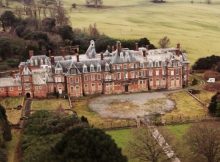Once grand and bustling with activity, they’ve long since been left to crumble in the elements or be swallowed up by nature.
In fact, all around Wales are derelict and neglected properties for which time has stood still since the last person to live in or love them slammed shut the front door that final time and walked away.
Portals to the past, or shells with potential for a new future, they remain hidden amidst the trees, behind imposing rusted gates or in lonely corners of forgotten fields – until, that is, someone happens to stumble across them again.
Occasionally, some have been taken on and, thankfully, given a new lease of life.
Hafodunos Hall
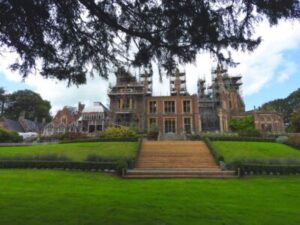
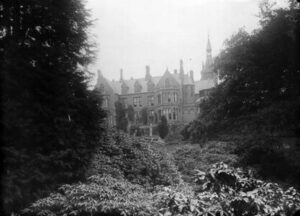
Hafodunos Hall, near Llangernyw, Conwy, has a beautiful historic garden that’s been undergoing restoration after 30 years of neglect and an arson attack. The garden was opened under the National Garden Scheme.
The Gothic revival house was designed by Sir George Gilbert Scott and built between 1861 and 1866 for Henry Robertson Sandbach, replacing a house that had been built in 1674. After being sold by the Sandbach family, Hafodunos subsequently housed Kent House school for Girls, which was based in Sale but acquired it as a site for evacuation during World War Two.
Dr Richard Wood purchased the mansion and garden in 2010, and has begun a restoration project to return Hafodunos to its former glory.
Kinmel Hall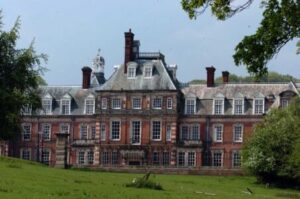
The ‘Welsh Versailles’ was once one of the finest homes in the land but now lies derelict and unloved.
A private home has been on the site of Kinmel Hall since the 12th century. The present Grade I 122-room building was finished in 1876 and funded by Robert Hughes, heir of a huge copper mining fortune.
It was the family’s home until 1929 and went on to be a boy’s school, a health spa, a military hospital, a hotel and a Christian conference centre.
The cost of its restoration has been estimated at £20 million.
Plas Glynllifon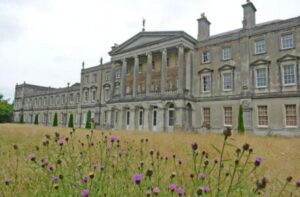
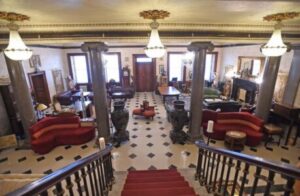
Plas Glynllifon was a grand neo-classical mansion built in the 1830-40s by Lord Newborough. It sits at the heart of a historical estate which exerted a profound influence over the landscapes and communities of Caernarfonshire for centuries.
In 1969, it played host to the Prince of Wales Investiture Ball but the mansion had lain empty for several years after a previous attempt to create a wedding venue failed. However, Paul and Rowena Williams took on the 102-room stately home in 2016 and announced multi-million pound plans to transform the house into a five star hotel. You can see the 50 best hotels in Wales here – and the country’s best restaurants here.
Cwrt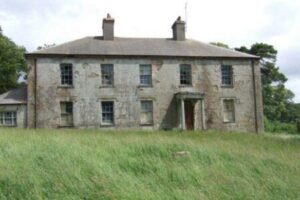
This derelict house is in Llanychaer in Pembrokeshire. According to Urban Ghosts Media , it has an intact roof despite its dilapidated exterior. The website also cites the 1811 Tour of Pembrokeshire book, in which Richard Fenton described the house as “a handsome modern mansion”.
“Today, its outbuildings are also in ruins and the tree stump in the foreground is all that remains of a cedar grown from a seed brought from the Holy Land,” says Urban Ghosts Media.
Edwinsford House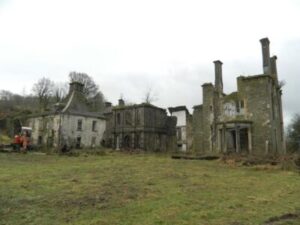
Grade II-listed Edwinsford was the residence of Sir Rice Williams, the high sheriff of Carmarthenshire in the 1680s.
Built on the left bank of the River Cothi, north of Llandeilo, in 1635, it fell into disrepair in the 1970s.
Cornist Hall
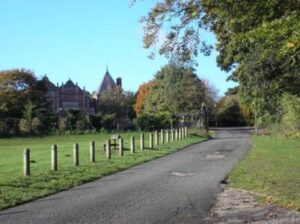
Cornist Hall, in Flint, is the birthplace of a navy admiral who served under Lord Nelson but it has sat unoccupied for several years and has become a regular attraction for vandals.
The building was the 18th century family home of Thomas Totty, who served under Nelson on several ships, including HMS Invincible. It was used as a dining and wedding venue until it closed its doors in 2013.
It was previously owned by members of the Summers family, who owned John Summers and Sons Ltd, a prominent iron and steel producer in Shotton. After being taken over by Clwyd Council in 1953, the house was modified for catering purposes. The building was under private ownership from 1987, before being sold to a new owner.
Golden Grove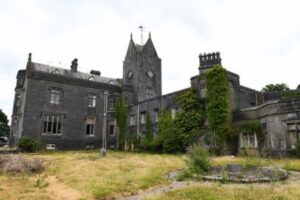
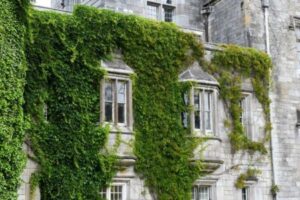
There have been three mansions on this Carmarthenshire estate. The first was built in 1560 by the Vaughan family. This was destroyed by fire and replaced in 1754. In 1804, the estate was bequeathed by John Vaughan, the last of the Golden Grove Vaughans, to his Oxford friend John Frederick Campbell, Lord Cawdor of Castlemartin, later the first Earl Cawdor, who demolished the previous property and built the existing house, designed by the leading architect Sir Jeffry Wyatville.
Golden Grove remained in Cawdor family occupation until 1935. During the Second World War it was occupied by the United States Air Force and, until 2003, by Coleg Sir Gar as an agricultural college.
Carmarthenshire council sold the Grade II listed, 59,000 square feet Golden Grove mansion and 100 acres of park and woodland, including a famous arboretum, in 2011. The park used to feature nature trails, a cafe and a children’s play area. But it has now deteriorated. There were plans to renovate it as a hotel, then as flats and a convalescent home for wounded armed forces veterans, but they came to nothing.
Ruperra Castle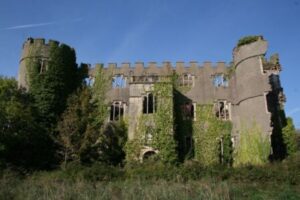
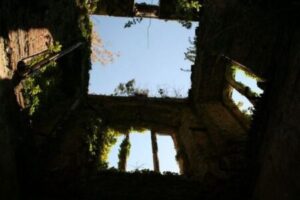
Built in 1626 by Sir Thomas Morgan near Caerphilly, it was one of the first ‘mock’ Tudor castles to be built in Wales. King Charles I spent two nights there in 1645.
It was bought as a home by John Morgan, a wealthy merchant, in the 18th century and was absorbed into the Tredegar estates of the Morgan family. It was destroyed by fire in 1785 but rebuilt and turned into a home again. In 2010 it was put up for sale for £1.5m after years of legal wrangles over the site
Iscoed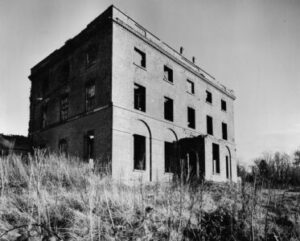
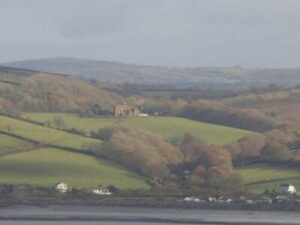
Iscoed, at Ferryside in Carmarthenshire, is a ruined eighteenth century mansion attributed to the architect Anthony Keck. It was built for Sir William Mansel in 1772 and purchased by the Napoleonic general Sir Thomas Picton in 1812. It remained in that family until the end of World War One.
Used subsequently as council housing, it has been empty since the 1950s, and is now a derelict shell. As of 2018, it was listed for sale by auction.
Great Frampton
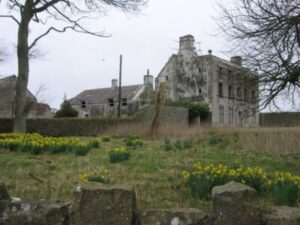
Great Frampton is a late 18th century front on a 16th centure house. Gutted by fire in the late 1990s, Great Frampton became a hollow shell. According to the website WelshRuins.co.uk , the famous astronomer, Nathaniel Pigott, stayed at Frampton, near Llantwit Major, during the 1770s and erected an observatory. Great Frampton also has a walled garden.
Red Dress Manor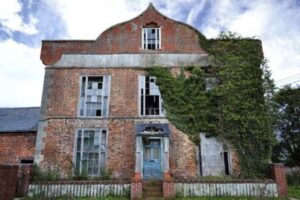
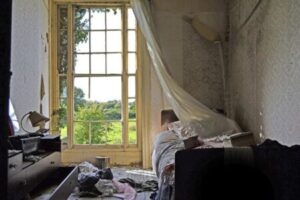
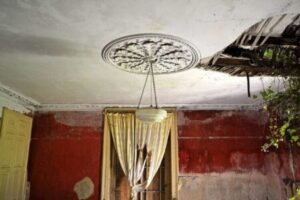
This grand-looking former dairy farm in Llanymynech, Powys, eerily displays signs of still being inhabited. Strewn with personal effects, including photographs, lights and clothes, were it not for the decades of dust covering them you’d think someone remained in residence there. It still has photos of the last owner hanging on the wall and even the dress that gives the derelict manor house its name can still be found inside.
The derelict dairy farm dates from 1725. In 2013, a photographer gained access and took these remarkable pictures .
Piercefield House
